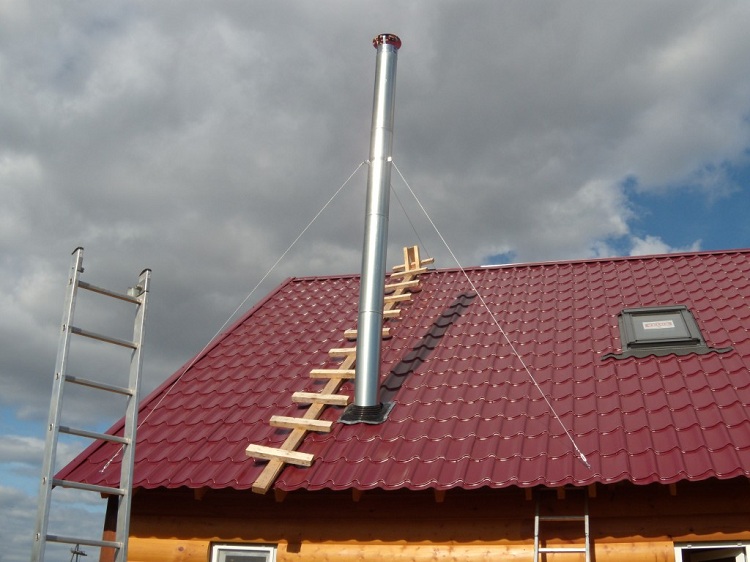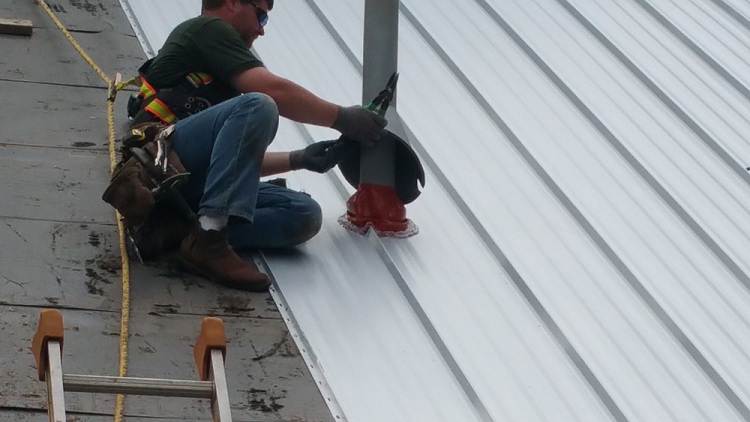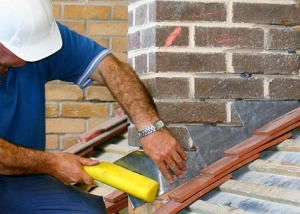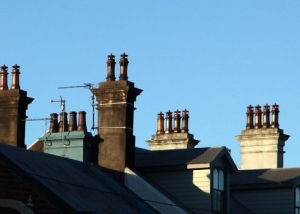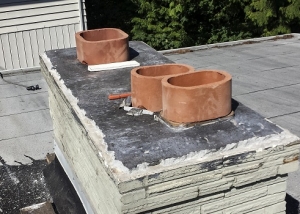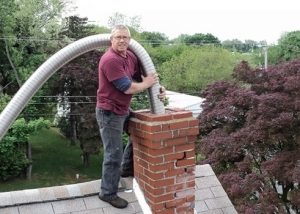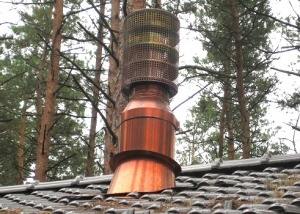Currently, boilers are used to heat most country houses. Such units must be equipped with structures that will remove carbon monoxide and smoke generated during the combustion of fuel. Chimneys for solid fuel boilers are structures without which the operation of the heating system is simply impossible. And this, in turn, puts forward special requirements, both to their device and installation.
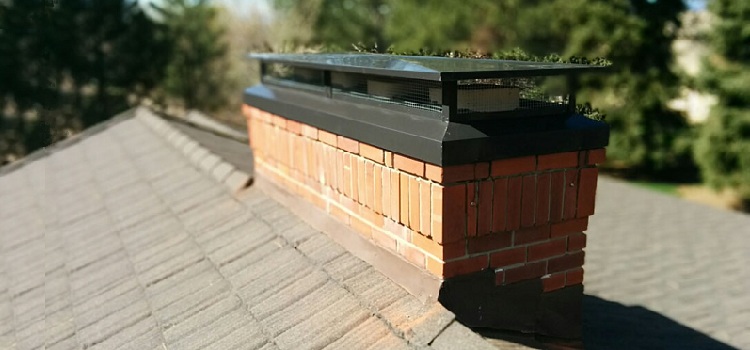
The main requirement for chimneys for solid fuel boilers is resistance to high temperatures, so not all types of pipes are suitable for such furnaces
Content
What are the chimneys
One of the main generally accepted criteria for the classification of flue systems is the material of manufacture.
Brick exhaust pipe. Structures of this type are most popular. Everyone knows the high refractoriness of a brick - it is able to withstand temperatures up to +900 ۫ C. However, for heating boilers with low efficiency, it is not recommended to be used. The reason is the features of this material. To get decent traction, it takes a lot of heat to warm the walls of the brick pipe for the boiler.
There are also several negative points. Due to the porosity of the brick, soot deposits accumulate on its surface. In addition, due to the fact that condensate precipitates from the flue gases, the strength of the masonry is reduced. In addition, not every homeowner can make a high-quality and correct chimney from this material with his own hands - this is quite difficult. And the last thing to say is the need for periodic cleaning, which is very troublesome, and it costs a lot of money.
Steel chimneys. A pipe for a solid fuel boiler of this type has practically no need for cleaning, because its inner surface is smooth. But structures made of ferrous metal are subject to corrosion, and this is a big minus. Therefore, experts recommend choosing stainless steel products. The advantages of this solution are as follows:
- the stainless steel exhaust pipe for the boiler is not afraid of temperature almost an order of magnitude higher: up to +7000 ۫ С;
- mounting such products is much easier. To build a steel chimney for a solid fuel boiler with your own hands can a person who has only basic building skills. Thus, saving money is ensured by the absence of the need to attract professionals whose cost of services is rather big.
But steel chimney pipes for boilers must be insulated without fail. After all, the metal heats up to a very high temperature, which can cause a fire.
Important! Particularly carefully insulated should be in places where steel chimneys pass for heating boilers through the roof, through the attic space and through the ceilings.
Ceramic chimneys. Chimney systems of this type are fireproof and have a long service life.Ceramics are obtained as a result of firing, and therefore can withstand high temperatures. This material does not contribute to ignition of soot deposits, and is itself not subject to combustion.
The boiler ceramic pipe resembles a shell in its design. In its middle layer there is a heater, as well as all the attributes necessary for connecting to a solid fuel boiler. Separate blocks with a length of 33 centimeters are made. Such dimensions allow you to install ceramic chimneys for solid fuel boilers with your own hands quickly and easily.
This material is environmentally friendly, the chimney systems created on its basis are able to withstand temperatures (attention!) Up to +12000 ۫ С! And, of course, they are not afraid of the effects of condensate and toxic gases.
Glass chimneys. Chimney structures made of refractory glass in the domestic market today are not widely demanded, as is the case in Europe and Asia. This phenomenon is explained by two factors:
- a glass chimney for a solid fuel boiler is relatively expensive;
- the population is not sufficiently informed about such products.
At the same time, high quality characteristics of glass chimneys allow them to compete with similar constructions with similar functionality. The source material is not susceptible to corrosion, its smooth surface prevents the formation of soot deposits, and it is able to withstand fairly high temperatures. And in the extreme case when the boiler glass pipe collapses (which can happen with the chimney from any other raw material), due to the peculiarities of the manufacturing technology, sharp fragments do not form, which reduces the risk of injury.
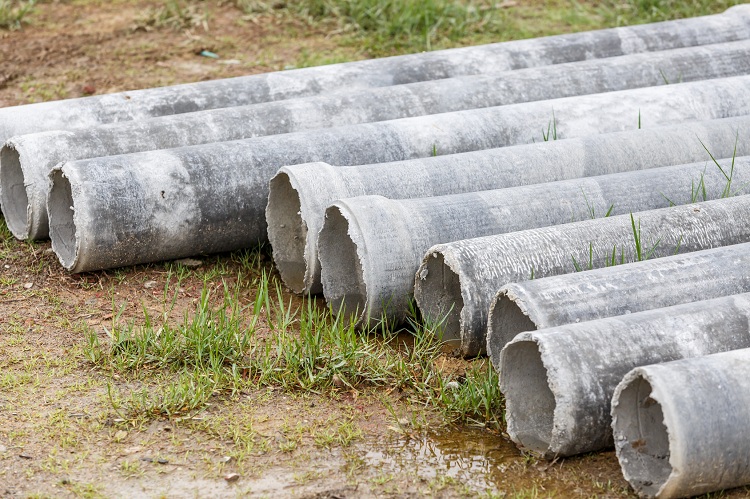
Asbestos-cement pipes - a budget option for the installation of the chimney, but their service life will be short
Among the disadvantages of such products, in addition to the relatively high cost, we can distinguish the complexity of installation. An ordinary homeowner will not be able to cope with such a task without the involvement of specialists.
Cement chimneys. In the recent past, these pipes were used, almost everywhere for the installation of smoke removal systems from heating devices, stoves and fireplaces. Now it is not practical to use them. This is due, firstly, to the fact that asbestos is destroyed at a temperature of +3000 ۫ С. And secondly, this material is characterized by low mechanical strength.
On a note! However, for those who are experiencing financial difficulties, this option has the right to life: asbestos pipes are inexpensive.
Chimney selection. Main criteria
The material for manufacturing a chimney for a solid fuel boiler is far from the only factor that you need to pay attention to when choosing a specific model of such a product. Consideration should also be given to:
- flue gas temperature;
- type of boiler by type of traction - natural or using a fan (forced);
- corrosion and condensation resistance;
- shape and dimensions of the internal section;
- pipe length and its location;
- Is it possible to do the installation yourself without involving professionals?
- ease of maintenance of chimneys for heating boilers.
It is understood that metal products are susceptible to corrosion. And there is one rule. Chimney materials for solid fuel boilers must have a 2nd or 3rd corrosion resistance class.
The choice of location of the device is carried out taking into account the material of the manufacture of walls and ceiling of the room. Both the chimneys and the enclosing structures are subject to the norms and tolerances contained in the relevant documents.
The quality of traction affects the creation of a comfortable temperature in the house, fuel consumption and the efficiency of a solid fuel boiler.And this parameter is, in turn, the value of the derivative of the size of the cross section and the shape of the design of the toxic gas removal system. The best is considered to be a chimney device for a solid fuel boiler, having the shape of a circle or oval. The laws of physics work here. If the boiler pipe has a rectangular or square cross section, the flue gases rising upward create turbulence. For this reason, traction is reduced, and soot and soot deposits form faster. This characteristic depends on the slope and the number of bends of the chimney boiler pipe: the less they are, the better the draft.
The chimney length is also affected by:
- type of roof and degree of steepness of its slope;
- type of roofing material;
- directions and strength of the prevailing winds in the region;
- pipe diameter.
The height of the chimney for a solid fuel boiler above the ridge of the roof is at least 50 centimeters, and its length should not go beyond 5-6 meters. Calculation of the diameter of the exhaust system of combustion products, in fact, as well as the development of its scheme, must be carried out at the design stage. It is advisable that a specialist do this work.
Features of the chimney for a gas boiler. Compound elements
In this case, the name "chimney" does not fully reflect the purpose of such a system. This is only the visible part of its functional orientation. In general, for such a complex and very important design, the definition of “ventilation system for a gas boiler” is more suitable.
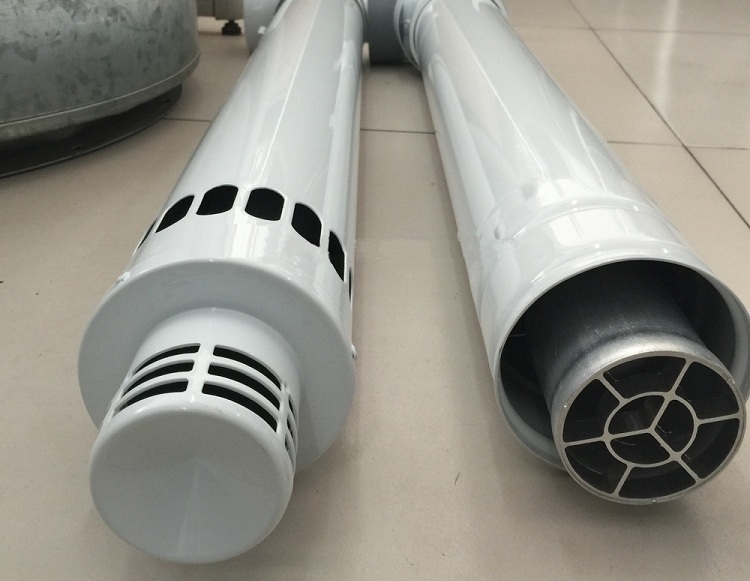
The coaxial type chimney is easy to distinguish in appearance; it is applicable only for gas equipment, they are not installed on solid fuel and other boilers
Important! The efficiency of the heating unit also depends on how correctly it is implemented.
Recently, the so-called chimney sandwich construction. They are made of two pipes of different diameters, one of which is inserted into the other. The space left between them is filled with a material that can withstand high temperatures (most often with basalt wool). Such a constructive solution of the ventilation duct is one of the most durable and effective.
Another common type of toxic gas exhaust system is a coaxial chimney. It differs in aesthetic and attractive appearance. The operational properties of the coaxial exhaust pipe for a gas heating boiler are also at a very high level. Condensation does not form on its walls, which is very important when using a heating unit of this type for heating a house.
The chimney pipe for a gas boiler (however, as for all other types of stoves) consists of the following elements:
- adapter. It connects the boiler outlet pipe to a discharge pipe;
- tee with revision. This element is equipped with a fitting through which condensed moisture is removed;
- fastenings - brackets and clamps;
- bends. They are used only if necessary. The bends are installed at a distance from the heating element of at least 2 meters. If this condition is not met, traction may decrease;
- pipes;
- transitional branch pipes;
- conical tip.
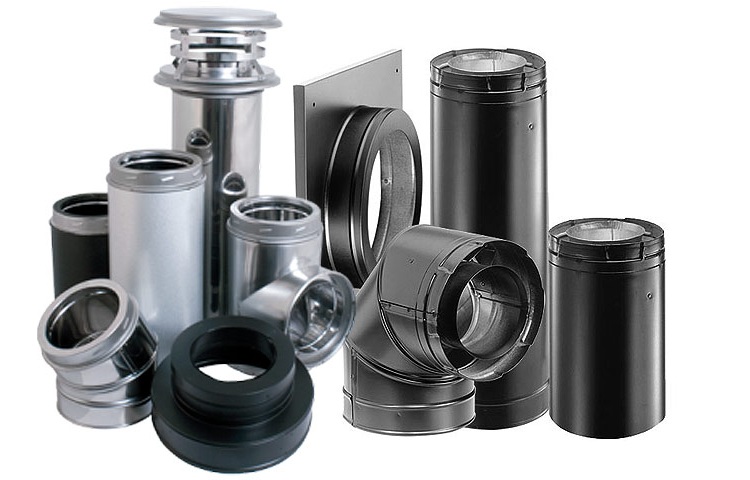
A steel chimney of the “sandwich” type is assembled from several segments, the system includes not only straight pipe sections, but also bends, tees, adapters and other elements
Installation of an external chimney
Installation of a toxic gas exhaust system, which is located outside the house, includes the following steps:
- an adapter passing through the wall is put on the boiler nozzle;
- part of the chimney is led out through the wall. All elements in contact with concrete (brick) must be carefully insulated;
- a stub is put on for revision. After that, it is attached to the outward segment;
- installation of a pipe of the required height from pre-purchased links is carried out.The created structure is attached to the wall of the house using clamps with brackets. The distance of neighboring fasteners from each other should not be less than 2 meters:
- when the chimney reaches the desired height, a cone-shaped tip is put on the upper element;
- all joints must be pulled together with steel wire or clamps;
- At the final stage, experts recommend that the piping of the ventilation systems be painted. So the material will be protected from corrosion, and the chimney itself will gain a more attractive appearance.
Important! If you do not use sandwich pipes, you will need to take care of the isolation of the elements of the chimney system yourself.
Stages of mounting an internal chimney
In this case, before starting work, some additional activities will be required:
- marking is applied to the places where the pipe passes through the roof and the floors;
- holes are cut in the right places. All dimensions should be carefully monitored so that the adapter pipes can be inserted as tightly as possible.
Having done this, proceed directly to the installation.
- Connect a special adapter to the pipe located at the boiler outlet.
- Attach to it a revision with a cover, necessary for cleaning the chimney.
- Install the base of the structure. As such, a metal sheet with a support bracket is used.
- Mount the pipe from direct components, as well as other necessary elbows (adapters). In places where the pipe passes through the ceiling, use special nozzles.
- Protect the points where the nozzles enter and exit the floors, with round metal sheets. Their diameter should be slightly larger than the cross section of the chimney.
- The connection points are additionally tightened with steel wire or bolted with cable ties.
- Install a special cone-shaped nozzle at the top of the created structure. It will prevent wind blowing into the cavity of the chimney system and atmospheric precipitation.
A chimney for a solid fuel or gas boiler is an integral part of a modern private house. The safety of its inhabitants and the efficiency of the heating system depend on it. Therefore, the choice of the chimney and its installation must be approached with all responsibility, otherwise mistakes made can lead to the most deplorable consequences.
